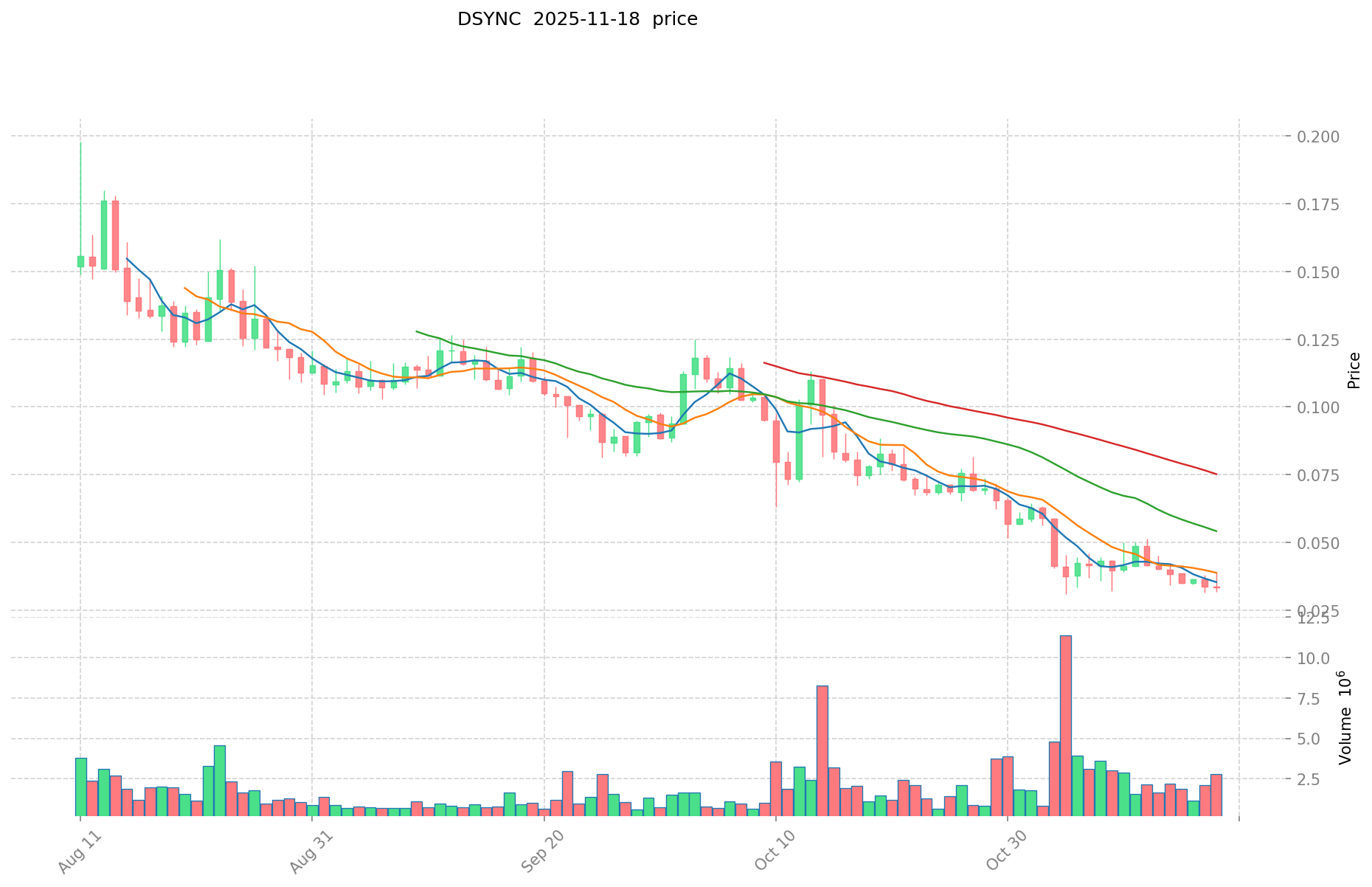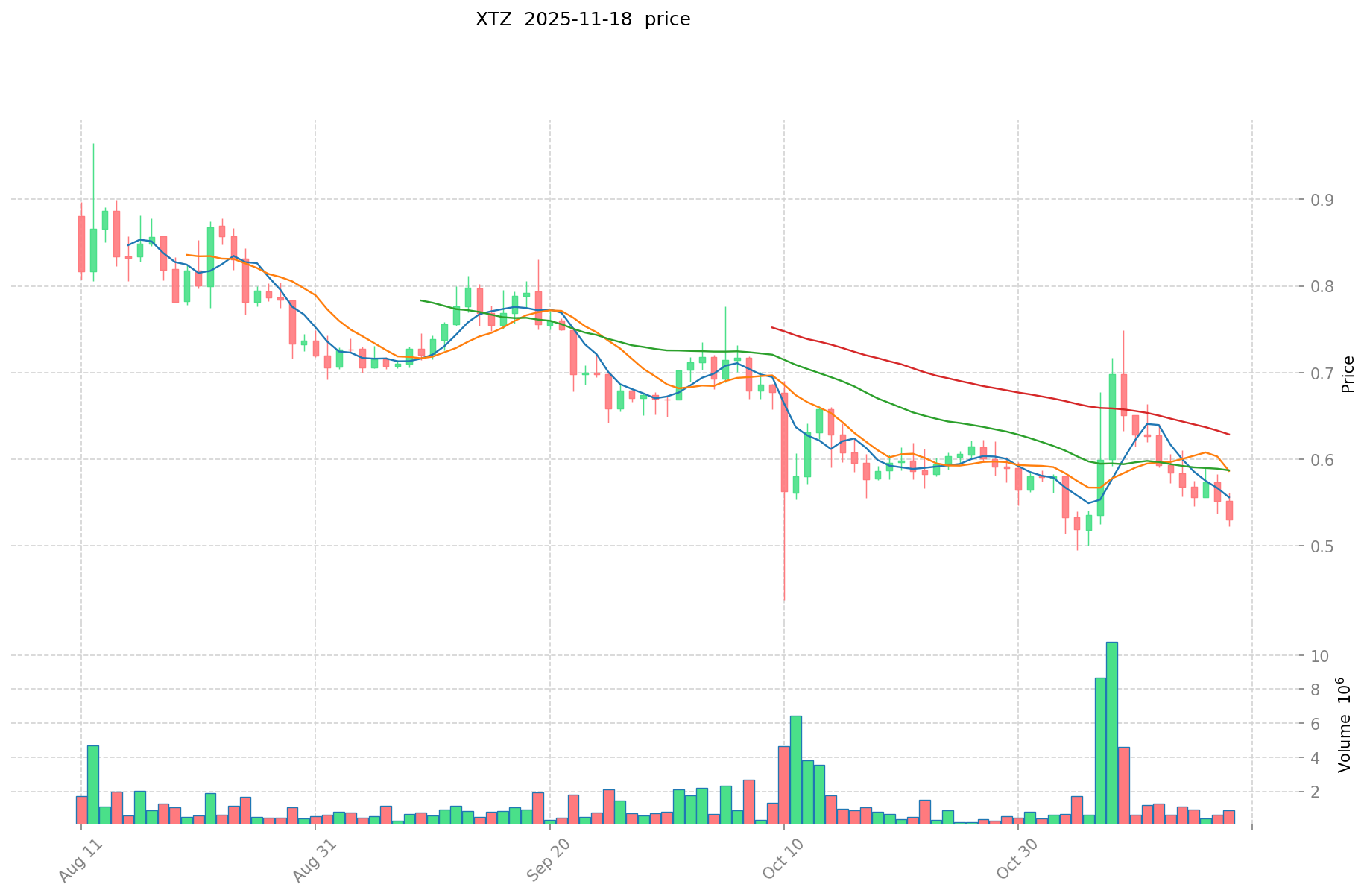DSYNC vs XTZ: Comparing Two Innovative Blockchain Platforms for Enterprise Solutions
Introduction: Investment Comparison between DSYNC and XTZ
In the cryptocurrency market, the comparison between Destra Network (DSYNC) vs Tezos (XTZ) has been an unavoidable topic for investors. The two not only differ significantly in market cap ranking, application scenarios, and price performance but also represent different positions in the crypto asset landscape.
Destra Network (DSYNC): Since its launch, it has gained market recognition for its decentralized ecosystem for cloud computing, AI, and web services.
Tezos (XTZ): Launched in 2017, it has been hailed as a self-amending cryptographic ledger, representing one of the pioneering platforms for formal verification in blockchain technology.
This article will comprehensively analyze the investment value comparison between DSYNC and XTZ, focusing on historical price trends, supply mechanisms, institutional adoption, technological ecosystems, and future predictions, attempting to answer the question investors care about most:
"Which is the better buy right now?"
I. Price History Comparison and Current Market Status
DSYNC and XTZ Historical Price Trends
- 2025: DSYNC reached an all-time high of $0.548 on January 6th, before declining to its current price.
- 2021: XTZ hit an all-time high of $9.12 on October 4th, driven by increased adoption and ecosystem growth.
- Comparative analysis: In the current market cycle, DSYNC has fallen from its peak of $0.548 to a low of $0.03081, while XTZ has declined from its 2021 high of $9.12 to current levels around $0.54.
Current Market Situation (November 19, 2025)
- DSYNC current price: $0.03398
- XTZ current price: $0.5414
- 24-hour trading volume: $66,016.40 (DSYNC) vs $318,980.74 (XTZ)
- Market Sentiment Index (Fear & Greed Index): 11 (Extreme Fear)
Click to view real-time prices:
- View DSYNC current price Market Price
- View XTZ current price Market Price


II. Core Factors Affecting DSYNC vs XTZ Investment Value
Supply Mechanism Comparison (Tokenomics)
- XTZ: XTZ has a cost of 0.257 XTZ for account recreation, with airdrops used to lower costs for affected accounts during hard forks
- DSYNC: Limited information available on supply mechanism
Institutional Adoption and Market Applications
- Institutional Holdings: Limited information available on institutional preference
- Enterprise Adoption: Limited information on enterprise applications for both tokens
- Regulatory Attitudes: Limited information on regulatory approaches across different countries
Technical Development and Ecosystem Building
- XTZ Technical Upgrades: XTZ is part of the Tezos ecosystem which focuses on decentralized finance applications
- DSYNC Technical Development: Limited information available on technical development
- Ecosystem Comparison: XTZ appears to have some DeFi applications, though specific details are limited in the provided information
Macroeconomic Factors and Market Cycles
- Performance in Inflationary Environments: Limited information on anti-inflationary properties
- Macroeconomic Monetary Policy: Limited information on how interest rates and USD index affect either token
- Geopolitical Factors: Limited information on cross-border transaction demands
III. 2025-2030 Price Prediction: DSYNC vs XTZ
Short-term Prediction (2025)
- DSYNC: Conservative $0.0242 - $0.0336 | Optimistic $0.0336 - $0.0393
- XTZ: Conservative $0.4414 - $0.5450 | Optimistic $0.5450 - $0.6431
Mid-term Prediction (2027)
- DSYNC may enter a growth phase, with estimated prices ranging from $0.0345 to $0.0448
- XTZ may enter a growth phase, with estimated prices ranging from $0.4643 to $0.7718
- Key drivers: Institutional capital inflow, ETF, ecosystem development
Long-term Prediction (2030)
- DSYNC: Base scenario $0.0465 - $0.0484 | Optimistic scenario $0.0484 - $0.0562
- XTZ: Base scenario $0.8897 - $1.0227 | Optimistic scenario $1.0227 - $1.5033
Disclaimer: This analysis is based on historical data and current market trends. Cryptocurrency markets are highly volatile and unpredictable. Always conduct your own research before making any investment decisions.
DSYNC:
| 年份 | 预测最高价 | 预测平均价格 | 预测最低价 | 涨跌幅 |
|---|---|---|---|---|
| 2025 | 0.0393471 | 0.03363 | 0.0242136 | -1 |
| 2026 | 0.039407634 | 0.03648855 | 0.034299237 | 7 |
| 2027 | 0.04477874856 | 0.037948092 | 0.03453276372 | 11 |
| 2028 | 0.0500497385388 | 0.04136342028 | 0.0306089310072 | 21 |
| 2029 | 0.051191368938528 | 0.0457065794094 | 0.03885059249799 | 34 |
| 2030 | 0.056200810041798 | 0.048448974173964 | 0.046511015207005 | 42 |
XTZ:
| 年份 | 预测最高价 | 预测平均价格 | 预测最低价 | 涨跌幅 |
|---|---|---|---|---|
| 2025 | 0.6431 | 0.545 | 0.44145 | 0 |
| 2026 | 0.6118715 | 0.59405 | 0.308906 | 9 |
| 2027 | 0.77178976 | 0.60296075 | 0.4642797775 | 11 |
| 2028 | 1.02418912995 | 0.687375255 | 0.35056138005 | 26 |
| 2029 | 1.18953724754025 | 0.855782192475 | 0.787319617077 | 58 |
| 2030 | 1.503309788411208 | 1.022659720007625 | 0.889713956406633 | 88 |
IV. Investment Strategy Comparison: DSYNC vs XTZ
Long-term vs Short-term Investment Strategies
- DSYNC: Suitable for investors interested in decentralized cloud computing and AI ecosystems
- XTZ: Suitable for investors focused on formal verification and self-amending blockchain technology
Risk Management and Asset Allocation
- Conservative investors: DSYNC: 30% vs XTZ: 70%
- Aggressive investors: DSYNC: 60% vs XTZ: 40%
- Hedging tools: Stablecoin allocation, options, cross-currency portfolios
V. Potential Risk Comparison
Market Risk
- DSYNC: Higher volatility due to lower market cap and trading volume
- XTZ: Potential market saturation in the smart contract platform space
Technical Risk
- DSYNC: Scalability, network stability
- XTZ: Potential security vulnerabilities in self-amending protocol
Regulatory Risk
- Global regulatory policies may impact both tokens differently, with potential scrutiny on decentralized services and smart contract platforms
VI. Conclusion: Which Is the Better Buy?
📌 Investment Value Summary:
- DSYNC advantages: Focus on decentralized cloud computing and AI services
- XTZ advantages: Established ecosystem, formal verification capabilities
✅ Investment Advice:
- New investors: Consider a balanced approach with a slight preference for XTZ due to its more established presence
- Experienced investors: Explore opportunities in both, with a higher allocation to DSYNC for potential growth
- Institutional investors: Conduct thorough due diligence on both projects, considering DSYNC for innovative exposure and XTZ for its established technical framework
⚠️ Risk Warning: The cryptocurrency market is highly volatile. This article does not constitute investment advice. None
VII. FAQ
Q1: What are the main differences between DSYNC and XTZ? A: DSYNC focuses on decentralized cloud computing, AI, and web services, while XTZ (Tezos) is known for its self-amending cryptographic ledger and formal verification capabilities in blockchain technology.
Q2: Which cryptocurrency has performed better historically? A: Based on the available information, XTZ reached a higher all-time high of $9.12 in October 2021, while DSYNC's all-time high was $0.548 in January 2025. However, both have experienced significant declines from their peaks.
Q3: What are the current prices and trading volumes for DSYNC and XTZ? A: As of November 19, 2025, DSYNC's price is $0.03398 with a 24-hour trading volume of $66,016.40, while XTZ's price is $0.5414 with a 24-hour trading volume of $318,980.74.
Q4: What are the price predictions for DSYNC and XTZ in 2030? A: For DSYNC, the base scenario predicts $0.0465 - $0.0484, with an optimistic scenario of $0.0484 - $0.0562. For XTZ, the base scenario predicts $0.8897 - $1.0227, with an optimistic scenario of $1.0227 - $1.5033.
Q5: How should investors allocate their portfolio between DSYNC and XTZ? A: Conservative investors might consider 30% DSYNC and 70% XTZ, while aggressive investors might opt for 60% DSYNC and 40% XTZ. However, these allocations should be adjusted based on individual risk tolerance and market conditions.
Q6: What are the main risks associated with investing in DSYNC and XTZ? A: DSYNC faces higher volatility due to lower market cap and trading volume, as well as potential scalability issues. XTZ risks include market saturation in the smart contract platform space and potential security vulnerabilities in its self-amending protocol. Both face regulatory risks that may impact decentralized services and smart contract platforms.
Share
Content